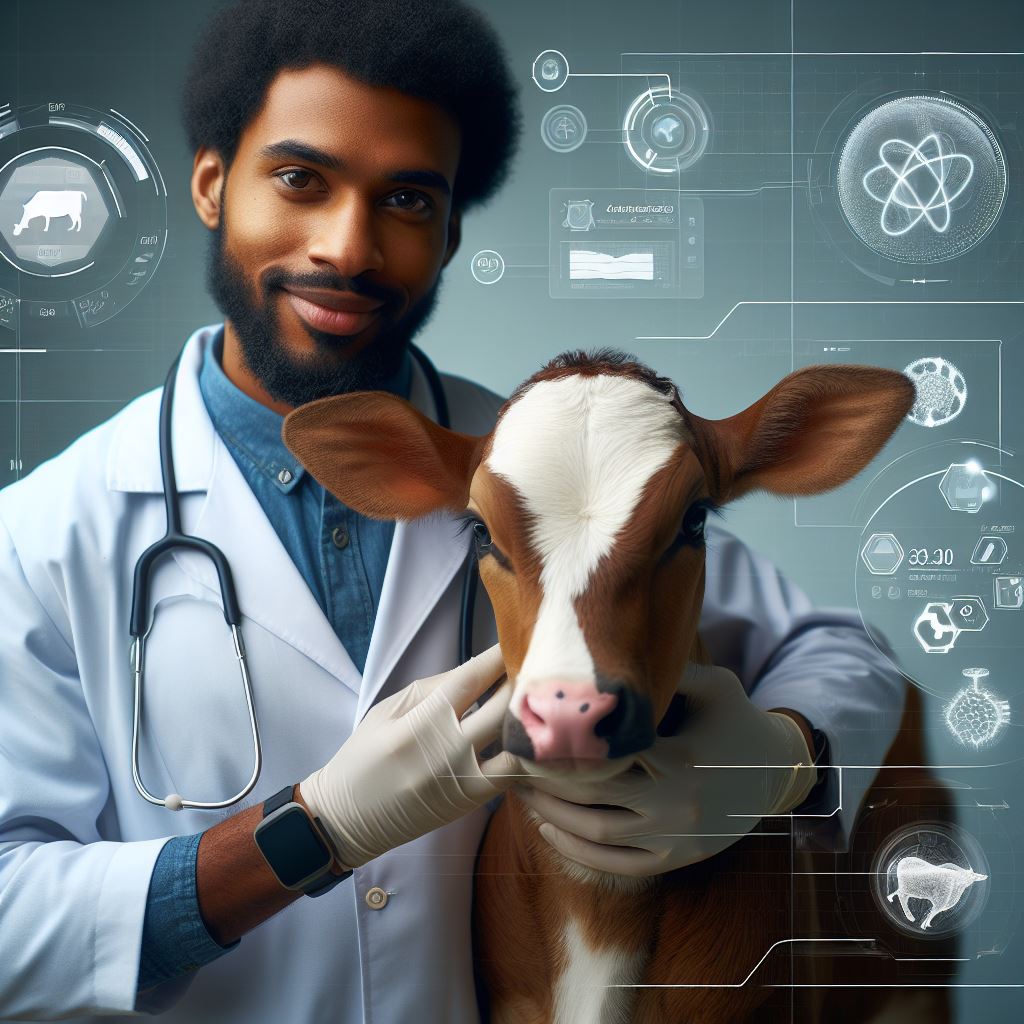Introduction
Let’s explore Breeding Tech: New Trends in Livestock Genetics.
Livestock breeding undergoes a revolutionary shift with cutting-edge technologies.
This section explores the transformative trends, including:
- Genomic Advancements: Unraveling the livestock genome for precise understanding and manipulation of genetic traits.
- CRISPR Technology: Revolutionary gene-editing techniques enabling targeted modifications for desirable traits.
- Precision Breeding: Enhancing accuracy in selecting and propagating desired genetic traits to improve livestock quality.
- Artificial Intelligence: Harnessing AI for advanced data analysis, aiding in predictive breeding and optimizing genetic outcomes.
- Blockchain Integration: Ensuring transparent and traceable breeding records, fostering trust in genetic data for livestock improvement.
Explore the frontier of livestock genetics, where innovation promises to redefine breeding practices and outcomes.
Traditional breeding methods
Explanation of selective breeding
Selective breeding, also known as artificial selection, is a breeding method that involves selecting and mating animals with desired traits to produce offspring with those traits.
- Traits can include improved growth rates, disease resistance, and increased milk or egg production.
- Selective breeding aims to enhance specific traits essential for economic gains and animal welfare.
- Breeding programs often focus on traits such as feed conversion efficiency and adaptability to different environments.
Advantages and limitations of traditional methods
Traditional breeding methods have been widely used for centuries, offering several advantages as well as inherent limitations.
Advantages
- Genetic diversity: Traditional breeding methods take advantage of the natural genetic variation within a population, allowing for the selection of diverse traits.
- Established techniques: Selective breeding techniques are well-established and have a proven track record in improving livestock productivity.
- Cost-effective: Compared to newer technologies, traditional breeding methods are generally more affordable and accessible for small-scale breeders.
Limitations
- Time-consuming: Traditional breeding methods require multiple generations of animals to achieve desired traits, making the process time-consuming.
- Limited precision: While selective breeding can enhance certain traits, it often lacks precision compared to modern genetic technologies.
- Undesirable traits: Selective breeding might inadvertently introduce undesirable traits, as they are often linked to the desired traits being selected.
- Inbreeding risk: Repeated mating between closely related individuals can increase the risk of genetic disorders caused by the accumulation of harmful recessive genes.
Lastly, traditional breeding methods, such as selective breeding, have been widely employed in livestock genetics for their advantages in utilizing natural genetic diversity and cost-effectiveness.
However, these methods also come with limitations, including time consumption and limited precision.
The risk of introducing undesirable traits and the potential for inbreeding highlight the need for alternative approaches in livestock breeding.
Despite their limitations, traditional breeding methods continue to play a significant role in livestock genetics.
The combination of traditional methods with modern technologies, such as genetic testing and marker-assisted selection, can further enhance the efficacy and precision of breeding programs.
This integration allows breeders to make informed decisions based on genetics and genotype data.
The future of livestock genetics lies in a balanced approach that combines traditional breeding methods with cutting-edge technologies.
By harnessing the power of both approaches, breeders can accelerate genetic progress, improve animal welfare, and meet the ever-growing demands of the livestock industry.
Read: Starting a Poultry Farm: Essential Steps & Tips
Transform Your Agribusiness
Unlock your farm's potential with expert advice tailored to your needs. Get actionable steps that drive real results.
Get StartedEmerging trends in livestock genetics
In recent years, there has been a significant shift in the field of livestock genetics towards emerging trends that are revolutionizing the way animals are bred and improved.
These advancements, such as genetic engineering and modification, marker-assisted selection, and genomic selection, have the potential to reshape the livestock industry and its practices.
Genetic engineering and modification
Introduction to gene-editing tools (e.g., CRISPR)
One of the most groundbreaking technologies in genetic engineering is the development of gene-editing tools like CRISPR.
This revolutionary tool allows scientists to edit DNA sequences with a high level of precision, enabling them to make specific genetic modifications.
Potential benefits and concerns
The use of gene-editing tools presents numerous potential benefits in livestock genetics.
It offers the possibility of introducing desirable traits, such as disease resistance or increased productivity, into animals at a much faster pace than traditional breeding methods.
However, concerns have been raised about potential ethical implications and the unintentional introduction of unintended genetic alterations.
Marker-assisted selection
Definition and process
Marker-assisted selection is a technique that uses DNA markers to predict an animal’s genetic potential.
By identifying specific genetic markers associated with desirable traits, breeders can select animals with the highest likelihood of passing on those traits to the next generation.
Advantages compared to traditional breeding
Marker-assisted selection offers several advantages over traditional breeding methods.
It allows breeders to make genetic improvements with greater precision by targeting specific traits of interest.
This approach also reduces the need for time-consuming and costly phenotypic evaluations, making the breeding process more efficient.
Genomic selection
Using of genomic data for breeding decisions
Genomic selection involves the use of genomic data, including DNA markers and sequencing information, to make breeding decisions.
By analyzing an animal’s entire genome, breeders can estimate its breeding value accurately and efficiently, even for traits that are difficult to measure directly.
Impact on breeding accuracy and efficiency
The use of genomic selection has significantly improved breeding accuracy and efficiency.
By utilizing genomic data, breeders can make more informed decisions, leading to faster genetic progress and the selection of animals with superior traits.
This approach has revolutionized breeding programs and accelerated the rate of genetic improvement in livestock populations.
In general, emerging trends in livestock genetics, such as genetic engineering and modification, marker-assisted selection, and genomic selection, bring novel opportunities to enhance animal breeding and productivity.
These advancements have the potential to address challenges in the livestock industry, increase sustainability, and improve traits that are important for animal health, welfare, and overall production efficiency.
However, it is crucial to consider the ethical, social, and regulatory aspects associated with these technologies to ensure responsible and beneficial implementation in livestock improvement programs.
Read: Aquaculture Insights: Fish Farming Tips
Applications of breeding tech in livestock
Breeding technology has revolutionized the livestock industry, offering numerous benefits such as disease resistance, improved quality, and productivity, as well as increased adaptability to various environmental conditions.
Disease resistance
One of the key applications of breeding technology in livestock genetics is the development of disease-resistant animals.
The susceptibility of livestock to diseases is greatly influenced by their genetics.
Showcase Your Farming Business
Publish your professional farming services profile on our blog for a one-time fee of $200 and reach a dedicated audience of farmers and agribusiness owners.
Publish Your ProfileCertain animals may be more predisposed to certain diseases, while others may possess genetic traits that enable them to resist them.
By identifying and selecting animals with desirable genetic traits, breeders can develop resistance to diseases in livestock populations.
This results in healthier animals and reduces the need for costly interventions such as antibiotics or vaccines.
Quality and productivity improvements
Breeding technology has also been utilized to enhance the quality of livestock products.
For instance, in the meat industry, breeders can selectively breed animals for traits such as marbling, tenderness, and flavor, resulting in higher-quality meat.
Similarly, in the dairy industry, breeding strategies can be employed to increase milk production in dairy cattle.
This not only benefits producers by increasing their yield but also meets the growing demand for milk and dairy products in the market.
Environmental adaptation
Livestock breeding technology can help animals adapt to various environmental conditions.
By selectively breeding for heat or cold tolerance, animals can withstand extreme temperatures and thrive in different climates.
This is particularly important in regions with harsh weather conditions, as it ensures the survival and productivity of livestock.
Furthermore, breeding for resilience can enable animals to withstand drought or other environmental challenges, reducing the negative impacts of climate change on livestock production.
Essentially, the applications of breeding technology in livestock genetics are diverse and impactful.
By utilizing genetic information, breeders can develop disease-resistant animals, improve the quality and productivity of livestock products, and enhance adaptability to various environmental conditions.
These advancements not only benefit producers but also contribute to sustainable and efficient livestock production.
Read: Aquaculture Health: Fish Disease Management

Find Out More: Rabbit Feed Types: Balancing Nutrition & Growth
Ethics and regulations in livestock genetics
Ethical considerations of genetic manipulation
In the field of livestock genetics, ethical considerations regarding genetic manipulation play a crucial role in shaping the direction of research and development.
- Animal welfare: When using breeding technologies, it is essential to prioritize the well-being and humane treatment of animals involved.
- Genetic diversity: Manipulating genes can lead to a reduction in genetic diversity, increasing susceptibility to diseases and decreasing adaptability.
- Unintended consequences: Altering genetic traits can have unforeseen consequences for both the animal and the environment.
- Moral concerns: Genetic manipulation raises moral concerns about playing “God” and the potential for creating unnatural or suffering-laden creatures.
Government regulations and oversight
The government plays a critical role in establishing regulations and overseeing the use of breeding technologies in livestock genetics.
- Animal welfare acts: Governments enact animal welfare acts to ensure that the use of genetic manipulation does not cause unnecessary harm to animals.
- Approval process: Breeding techniques and genetic modifications often require government approval before they can be used in the livestock industry.
- Research restrictions: Governments may impose restrictions on certain types of genetic research to prevent unethical practices and protect public interests.
- Monitoring and enforcement: Governments establish agencies or departments to monitor and enforce compliance with regulations related to livestock genetics.
Public perception and acceptance of new breeding tech
Public perception and acceptance of new breeding technologies play a crucial role in shaping the future of livestock genetics.
- Consumer preferences: Public opinion and consumer demands influence which breeding technologies gain acceptance in the market.
- Ethics and values: People’s individual ethics and values play a significant role in determining their acceptance or rejection of genetically modified livestock.
- Communication and education: Accurate and transparent communication about breeding technologies can help shape public perception and understanding.
- Cultural and religious beliefs: Cultural and religious beliefs may influence public acceptance of genetic manipulation in livestock breeding.
- Environmental concerns: Public concerns about the environmental impact of specific breeding technologies can influence acceptance or rejection.
Generally, ethics and regulations are critical components in the field of livestock genetics.
Consideration of ethical implications, government oversight, and societal acceptance are key to responsible and sustainable development in this field.
Read: Biosecurity in Livestock Farms: Key Practices
Future Prospects and Challenges
Potential Advancements and Breakthroughs
Livestock genetics is bound to undergo significant advancements in the near future.
Researchers are exploring various avenues to improve breeding techniques and enhance the genetic potential of livestock.
- Genomic Selection: The use of genomics to identify superior traits and select breeding animals will become more widespread, leading to accelerated genetic progress.
- Gene Editing: Techniques like CRISPR-Cas9 hold immense potential for targeted genetic modifications, allowing for the removal of undesirable traits and the introduction of beneficial traits.
- Precision Breeding: Advancements in reproductive technologies such as artificial insemination and embryo transfer will enable breeders to produce superior offspring with greater efficiency.
Technical and Economic Constraints
While the future holds promising advancements, there are certain technical and economic constraints that need to be addressed.
- Cost: Implementing cutting-edge breeding technologies can prove expensive, limiting their accessibility to small-scale breeders.
- Expertise: Utilizing advanced techniques requires specialized knowledge and skills, posing a challenge for breeders lacking the necessary expertise.
- Infrastructure: Adequate infrastructure and facilities are vital for the successful implementation of advanced breeding technologies, especially in remote areas.
Balancing Safety, Productivity, and Sustainability
As livestock genetics continue to progress, it becomes crucial to strike a balance between safety, productivity, and sustainability.
- Safety: Ensuring the safety of genetically modified animals is paramount to prevent any potential negative impacts on human health or the environment.
- Productivity: Breeding for improved productivity should not compromise animal welfare or genetic diversity, necessitating careful consideration of selection criteria.
- Sustainability: Breeding practices should contribute to the sustainability of livestock production systems, minimizing the environmental footprint and conserving resources.
Most importantly, the future of livestock genetics is filled with potential advancements and breakthroughs that could revolutionize breeding techniques.
However, challenges related to technical and economic constraints need to be overcome.
Striking a balance between safety, productivity, and sustainability is fundamental to ensure the responsible development and utilization of these technologies.
Conclusion
Recap of the importance of breeding tech in livestock genetics
Breeding technology plays a vital role in advancing livestock genetics, enabling us to enhance desirable traits and improve overall productivity.
Highlighting the potential benefits and challenges ahead
As breeding technology continues to advance, we can expect numerous benefits such as increased disease resistance, improved feed efficiency, and enhanced meat quality.
However, we also need to address the ethical concerns and potential risks associated with genetic manipulation.
Overall, breeding tech has revolutionized the livestock industry, offering immense opportunities for genetic improvement.
But while we embrace the potential benefits, we must ensure responsible and ethical practices to safeguard animal welfare and maintain consumer trust.




